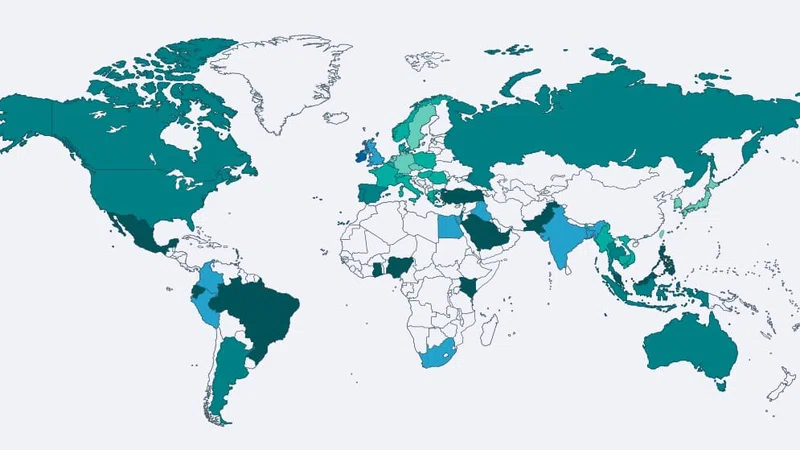The Boston Consulting Group (BCG) published a report in 2018 with the title “Digital Lending: A $1 Trillion Opportunity Over the Next 5 Years”. BCG touted that the total digital lending in India would grow fivefold and digital lending in these five years will in aggregate cross US$1 trillion. This fivefold growth would be supported by both a rapid increase in retail loan disbursements and rapid digital adoption in India.
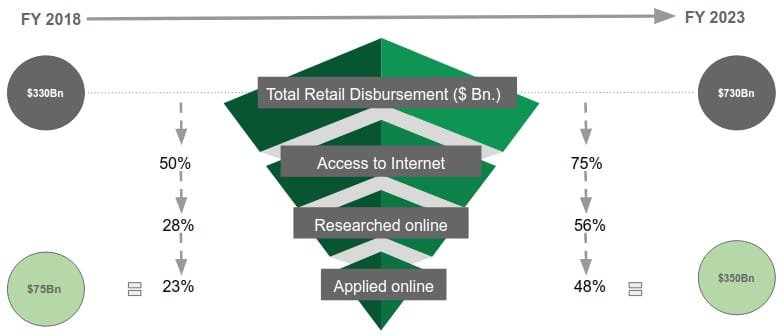
Data: (The Boston Consulting Group (BCG))
This claim was supported by a plethora of other evidence that pointed to a large gap in the potential credit market and supply by the traditional players. Regulators in India recognized the issue and developed a supportive policy and technology framework over the years. The Digital Credit was poised to grow rapidly in India but then the COVID-19 pandemic happened. In this article let us appraise the digital lending landscape in India - what changed, what did not and how it is going to impact the future of this sector.
Digital Lending Opportunity in India: Pre-COVID-19
The private Debt to GDP ratio in India is considerably low.
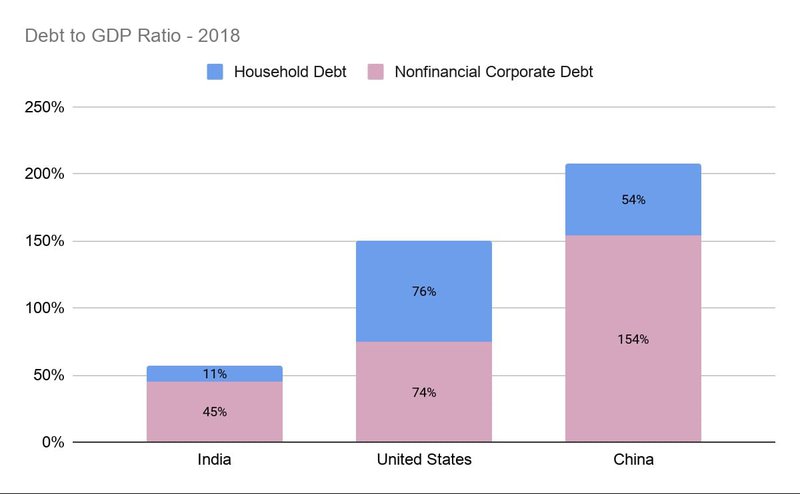
Data: (International Monetary Fund) (2018)
Private debt, loans, and debt securities as % of GDP
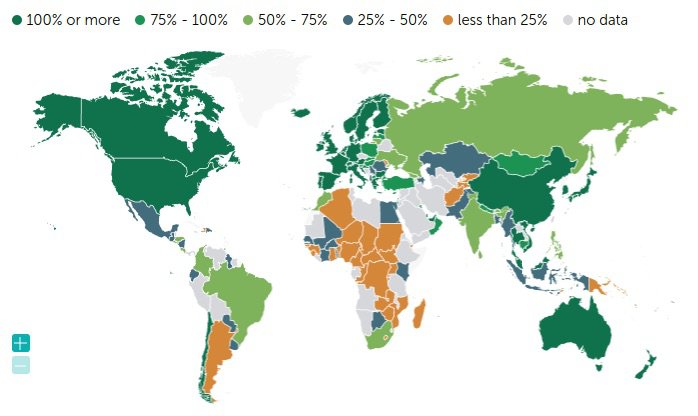
Source: (International Monetary Fund) (2018)
As per IFC data, the finance gap for Indian MSMEs stood at around US$ 397.5 billion as of 2018. One of the reasons is the lack of data available for the ‘new to credit’ or ‘thin-file’ borrowers. With a lack of data that can be used to evaluate creditworthiness, these borrowers lack access to credit from traditional players. Apart from that, high customer acquisition costs and operating costs of the traditional players often discourage them from lending to borrowers who require smaller amounts for a short duration.
Another part of the story is Indian millennials who are already the largest driver of Indian consumption growth. As per Morgan Stanley, there are more than 400 million Millennials in India - 46% of the workforce and contributing 70% of household income. This is a digitally connected aspirational generation who want instant gratification, very different from the more financially conservative previous generations.
Driven by the Millenials, India is becoming more and more comfortable with using credit for consumption. The number of outstanding Credit Cards increased at a CAGR of 25% between 2015 and 2019. The number of Credit Cards increased by more than 11 million only in 2019 (Reserve Bank of India).
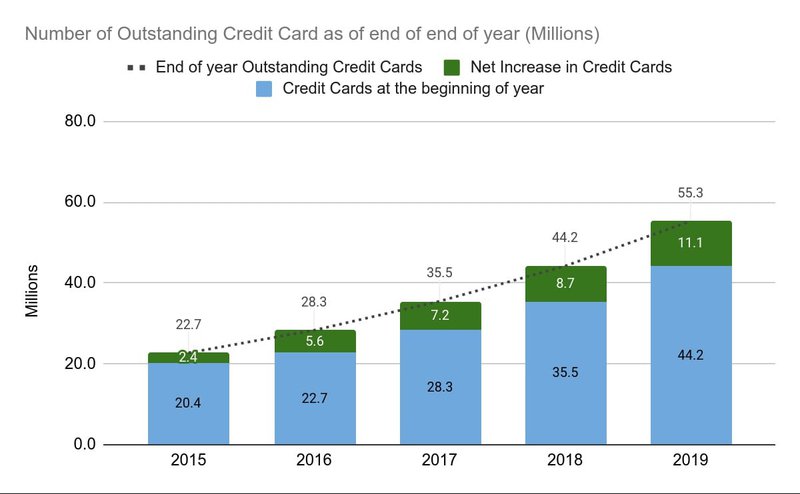
Data: (Reserve Bank of India)
The point-of-sale credit transaction value was at Rs. 212 billion in December 2015. By December 2019 the value stood at Rs. 662 billion - a threefold increase. (Reserve Bank of India)
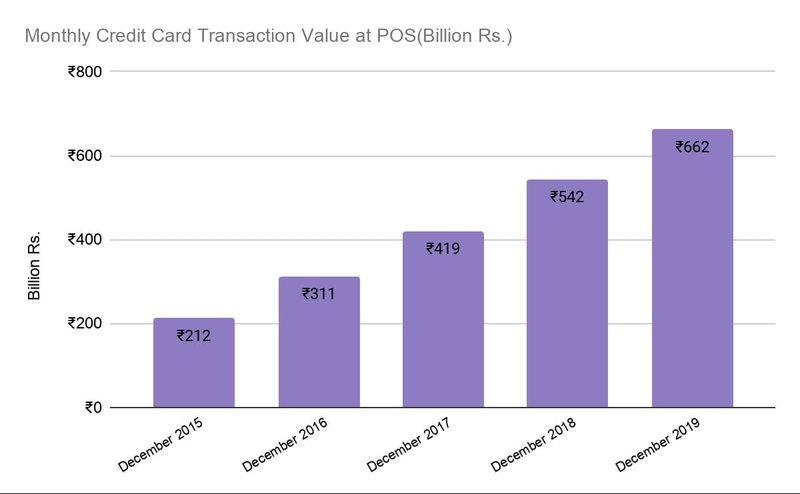
Data: (Reserve Bank of India)
Before we look into the impact of COVID-19, let us review the policy and technology structure for the sector in India. I admit the following few paragraphs are going to be a little dry. But, understanding the ecosystem is important to really judge the effect of COVID.
Policy Structure
Non-Banking Financial Company (NBFC)
Most Digital lenders in India are registered as NBFCs or work as distribution agents of NBFCs. NBFCs are defined by the Reserve Bank of India (RBI) as “A Non-Banking Financial Company (NBFC) is a company registered under the Companies Act…. engaged in the business of loans and advances, acquisition of shares/stocks/bonds/debentures/securities issued by Government or local authority or other marketable securities of a like nature, leasing, hire-purchase, insurance business, chit business but does not include any institution whose principal business is that of agriculture activity, industrial activity, purchase or sale of any goods (other than securities) or providing any services and sale/purchase/construction of immovable property.”
Over the years, RBI came up with various ways to classify NBFCs - Liability-based, Asset-based, and Size-based. On 22nd January 2021, RBI released a discussion paper on a new Scale-based classification system that creates a four-layered structure for regulating non-banking finance companies (NBFCs) in light of the recent defaults such as those at Infrastructure Leasing & Financial Services (IL&FS) and Dewan Housing Finance Corp. Ltd (DHFL).
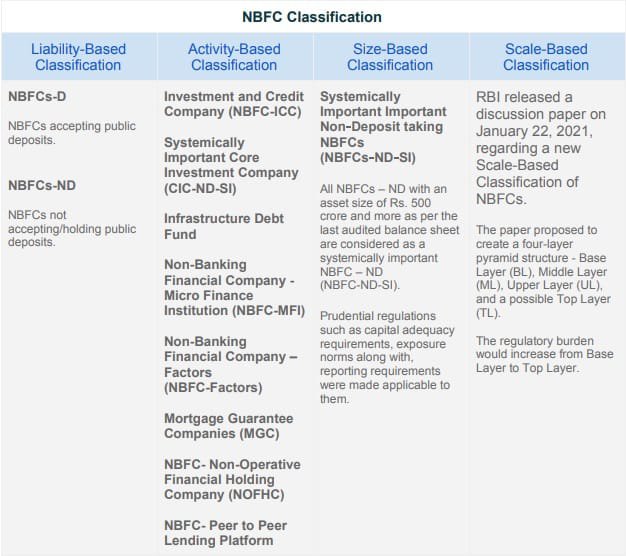
National Strategy for Financial Inclusion 2019-2024
Policies that influence the Digital Lending sector are often guided by the mandate of financial inclusion. So, what does the mandate say?
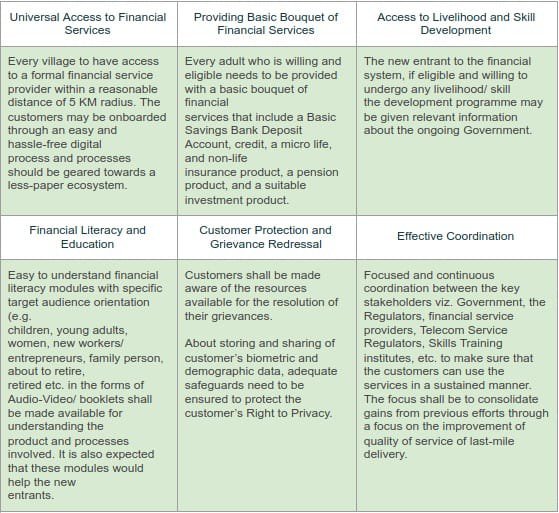
The Personal Data Protection Bill, 2019
Credit-related data comes under ‘Financial Data’ which is classified as “Sensitive Personal Data” under the Personal Data Protection Bill, 2019 and requires special care mentioned under Chapter IV of the bill. (PRS)
Pradhan Mantri MUDRA Yojana (PMMY)
A major opportunity for the Digital Lending industry is lending to small businesses. Micro Units Development and Refinance Agency Ltd. or MUDRA offers refinancing to Banks / MFIs / NBFCs for lending to micro units having loan requirements up to Rs. 10 lakhs. (MUDRA)
Technology Framework
UIDAI- Aadhar
Aadhaar number is a 12-digit random number issued by the UIDAI (“Authority”) to the residents of India after satisfying the verification process laid down by the Authority. Any individual, irrespective of age and gender, who is a resident of India, may voluntarily enroll to obtain an Aadhaar number. The Aadhaar (Targeted Delivery of Financial and Other Subsidies, Benefits and Services) Act, 2016 makes the Unique Identification Authority of India (UIDAI) the authority of the Aadhar process.
To date, more than 1.28 billion Aadhar numbers have been generated and more than 8.8 billion eKYC has been done. Aadhar based e-KYC process helps the digital lending platforms substantially reduce the turnaround time for processing loan applications by making the verification process completely paperless. (UIDAI)
Jan Dhan - PMJDY
Pradhan Mantri Jan-Dhan Yojana (PMJDY) is National Mission for Financial Inclusion to ensure access to financial services, namely, Banking/ Savings & Deposit Accounts, Remittance, Credit, Insurance, Pension in an affordable manner. An account can be opened in any bank branch or Business Correspondent outlet. Accounts opened under PMJDY are being opened with a Zero balance. (Ministry of Finance, GOI)
As per the latest records - 274 million beneficiaries in rural/semi-urban and 142.5 million beneficiaries in urban areas - a total of 416.5 million. (Ministry of Finance, GOI)
A bank account is the first step towards financial inclusion and adoption of financial services.
India Stack
IndiaStack is a set of APIs that allows governments, businesses, startups, and developers to utilize a unique digital Infrastructure to solve India’s hard problems towards presence-less, paperless, and cashless service delivery.
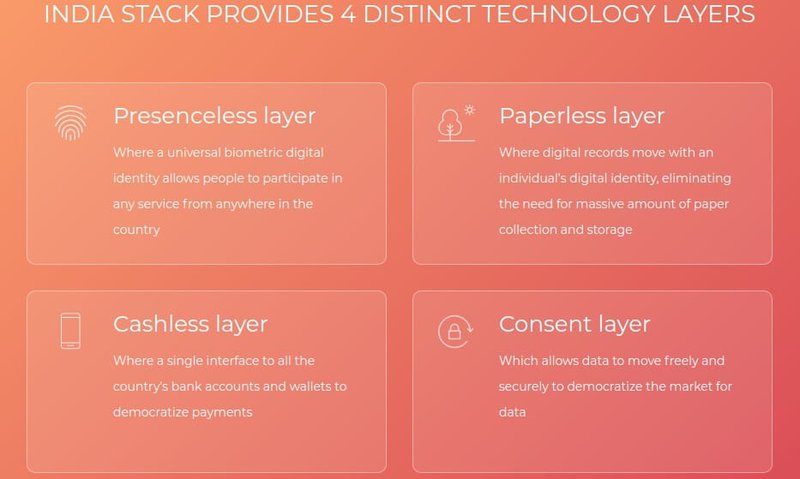
Source: (IndiaStack)
Architecture:
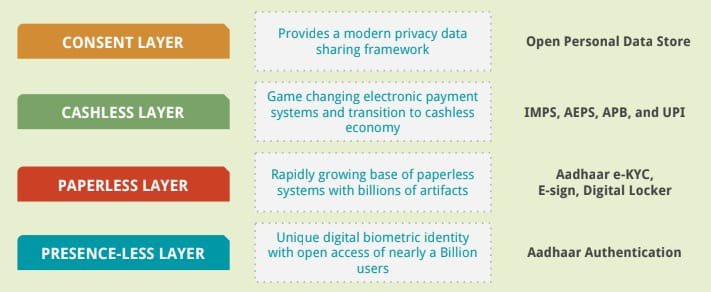
Source: (IndiaStack)
Services:
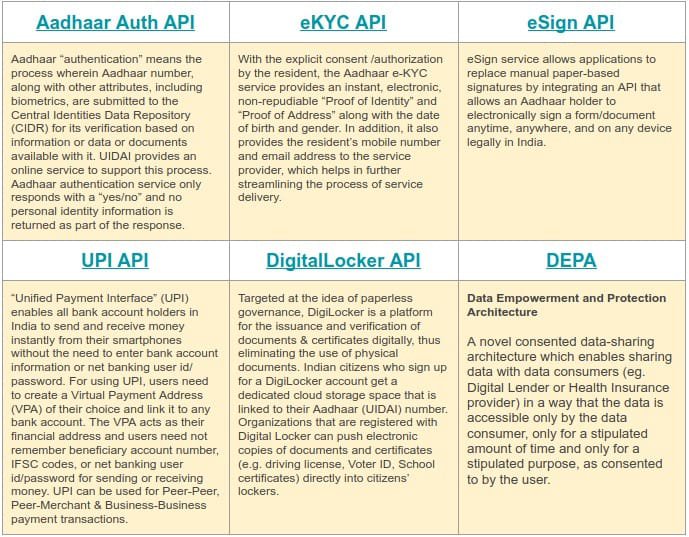
Consumer Lending Using India Stack
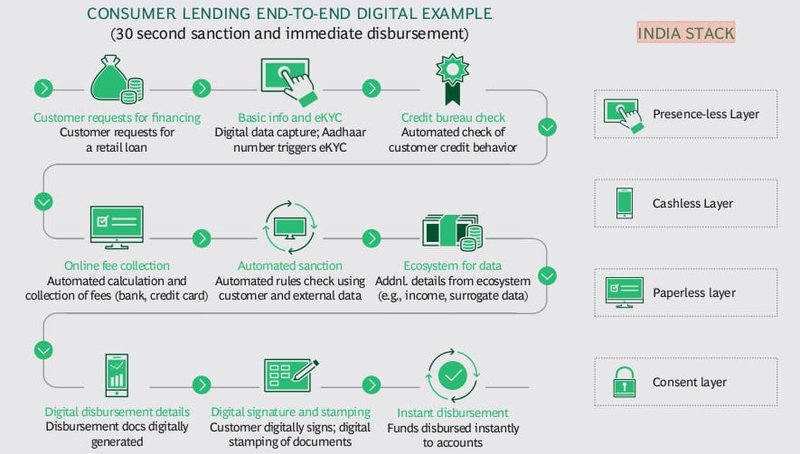
Source: (The Boston Consulting Group (BCG))
Government e-Marketplace (GeM)
GeM is a short form of one-stop Government e-Market Place hosted by DGS&D where common user goods and services can be procured. GeM is a dynamic, self-sustaining, and user-friendly portal for making procurement by Government officers.
Presently more than 7400 products in about 150 product categories and hiring of transport service are available on the GeM POC portal. Transactions for more than Rs 140 Crore have already been processed through GeM. (Ministry of Electronics & Information Technology, GOI)
GeM is a completely paperless, cashless, and system driven e-marketplace that enables procurement of common use goods and services with minimal human interface.
The transaction data at GeM is a credible source of data for extending working capital financing.
Recently GeM has partnered with some banks for payment-related services and it is also reported that GeM is working with Banks, TReDs, and SIDBI to provide bill discounting and financing of working capital where the cost of capital is linked to the performance and rating of a seller on the marketplace.
Trade Receivables Discounting System (TReDS)
TReDS is an electronic platform for facilitating the financing / discounting of trade receivables of Micro, Small, and Medium Enterprises (MSMEs) through multiple financiers. These receivables can be due from corporates and other buyers, including Government Departments and Public Sector Undertakings (PSUs). (Reserve Bank of India)
Currently, TReDS license has been issued to three players: Receivables Exchange of India Ltd (RXIL), a joint venture between Small Industries Development Bank of India (SIDBI) and National Stock Exchange of India Limited (NSE); Invoicemart, promoted by A Treds Ltd (a joint venture of Axis Bank and mjunction services); and M1Xchange, promoted by Mynd Solutions Private Limited.
Unified Payments Interface (UPI)
Unified Payments Interface (UPI) is a system that powers multiple bank accounts into a single mobile application (of any participating bank), merging several banking features, seamless fund routing & merchant payments into one hood. It also caters to the “Peer to Peer” collect request which can be scheduled and paid as per requirement and convenience.
As per the latest records, there are 207 Banks live on UPI, recorded 2.21 billion transactions per month, and more than Rs. 3.9 trillion worth of transactions (Nov 2020). (NPCI)
The success of UPI may lead to new open-banking initiatives in India.
Goods and Services Tax (GST)
Lack of cash-flow data is a major issue in the credit assessment of SMEs making credit too expensive for lenders. The GST database can solve that problem by creating a comprehensive and credible database that can reduce risks and cut costs while scoring these businesses for creditworthiness.
GST database is beneficial for cash-flow based lending (Eg. working capital financing). For example, ICICI Bank started MSME lending based on GST data.
Public Credit Registry (PCR)
A public credit registry refers to an extensive database of credit information of borrowers that is accessible to all lending and credit decision-making institutions. Typically, the registry is managed by a public authority like the central bank of the country, and reporting of loan details to the registry by lenders and/or borrowers is mandated by the law.
Presently India has both private and public sector entities storing credit data but the current system has various shortcomings such as lack of comprehensive data, time lag, and discrepancies between sources, etc.
These shortcomings lead to various inefficiencies in the credit market.
The National Strategy for Financial Inclusion 2019-2024 set a goal of making a fully functional PCR by March 2022.
Open Credit Enablement Network (OCEN)
OCEN is a credit protocol infrastructure built by the Indian Software Product Industry Roundtable (iSpirt). The OCEN framework is likely to allow any consumer-facing company to become a Loan Service Provider (LSP) using API interfaces. This is expected to affect the credit industry similar to what UPI has done for the payments industry. (iSPIRT)
Digital Lending Players in India
The business cases for Digital Lending can be classified into two major groups - Consumer Finance and Business Finance. Use cases in Consumer Finance include checkout finance, credit lines, and personal loans. Use cases for Business Finance include working capital finance, term loans, etc.
Some players are focused on Consumer Finance. Examples include MoneyTap which offers credit line to the consumers through a mobile app, Rupeek which is an internet-enabled lending platform connecting lenders and borrowers for gold loans, True Balance which is an app-based platform for consumer loans, ZestMoney which offers point-of-sale financing to consumers, Auxilo which offers education loans to students and Kissht which offers a line of credit to buyers to make online purchases.
Examples of players focusing on Business Finance are Lendingkart which is a web platform that enables SMEs to apply for collateral-free working capital loans, NeoGrowth which offers merchant cash advance to businesses, and OfBusiness which offers raw material purchase financing, working capital financing, and capital expenditure financing to SMEs, etc.
Some other players such as InCred, Capital Float, and Vivriti Capital provide both Consumer and Business Finance.
Digital Lending and COVID-19
When the COVID-19 hit the Indian economy, things changed quickly. Consumer credit use drastically dropped in April 2020 and is expected to take some time to recover.
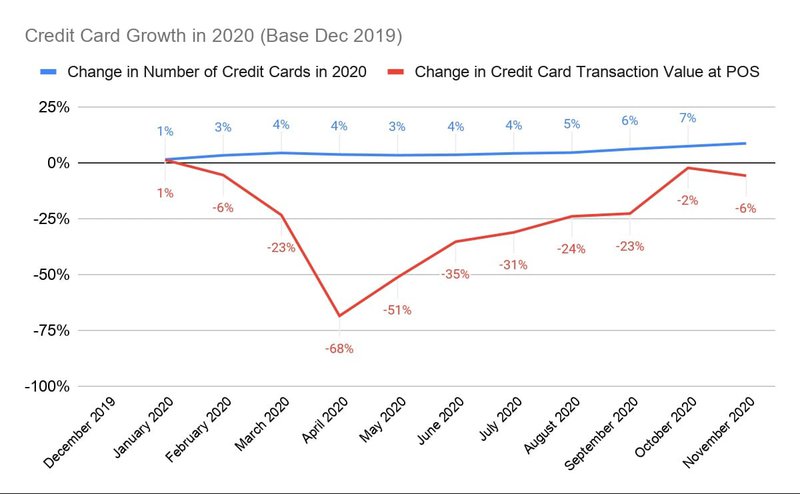
Data: (Reserve Bank of India)
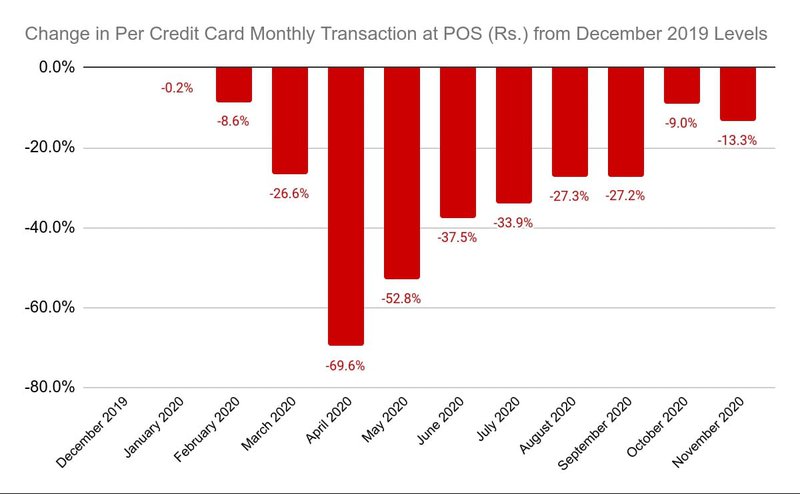
Data: (Reserve Bank of India)
Credit to the industry by Scheduled Commercial Banks was lackluster - Micro and Small companies were hit the hardest as banks avoided credit to small companies and lower policy rates took time to reach the borrowers. In May 2020 the Government announced the Emergency Credit Line Guarantee Scheme (ECLGS) under the Atmanirbhar Bharat package. Credit demand from the medium-size enterprises recovered but credit demand from the micro and small players may take some to recover.
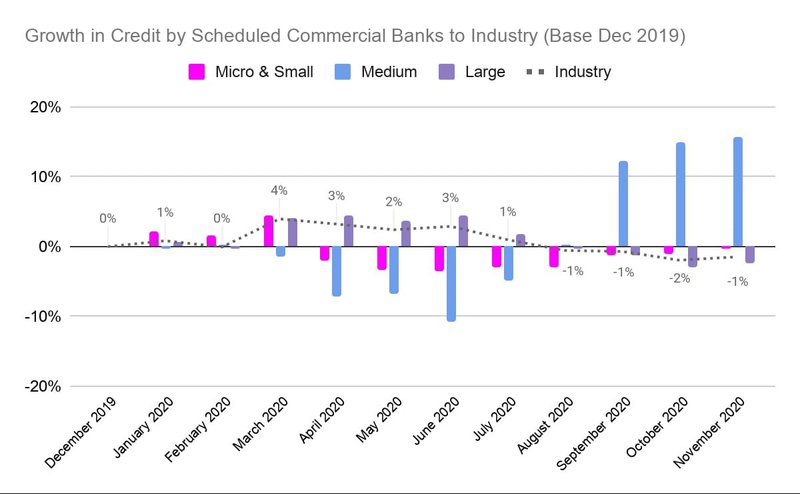
Data: (Reserve Bank of India)
The impact of this drop in demand was varied in the Indian Digital Lenders. Capital Float reported a 350% growth in its buy-now-pay-later (BNPL) customer base in 7 months when compared to FY20. At the same time, Lendingkart laid off 30% of the workforce due to lower credit demand from the MSME sector.
Anticipating the economic impact of the COVID, the Indian government quickly took some policy steps. Some of those policy steps were a partial Credit Guarantee Scheme offered to Public Sector Banks (PSBS) to purchase of pooled assets of rating BBB+ or above from sound NBFCs and HFCs, portfolio guarantee for purchase by PSBs of Bonds of Commercial Papers (CPs) with a rating of AA or below issued by NBFCs/ HFCs and MFIs, a moratorium on term loans, deferment of interest on working capital facilities, reduction of policy repo rate, and various measures to increase liquidity in the financial system, etc.
Under the Aatma Nirbhar Bharat Abhiyaan, the Indian Government announced various schemes to support the MSME sector - collateral-free loans, special corpus for MSMEs, subordinate debts, etc.
While one part of the story involves a drop in demand, the other part involves stressed assets. As per CRISIL, NBFC delinquencies may see a 250 bps increase in FY 2020-21 even after the RBI allowed the restructuring of advances to MSMEs. The Asset Under Management is also expected to see degrowth.
In the meantime, policy and technology frameworks are also going through changes. In June 2020, RBI released a guideline raising concern over the lack of transparency in the digital lending sector. In December, RBI issued a statement cautioning about unauthorized digital lenders after many loan app scams came to light. In January 2021, RBI constituted a working group on the regulation of digital lending in India. A few days after that, RBI proposed the new Scale-based classification of the NBFCs as per which the large NBFCs would be regulated like banks.
At the same time, standardization is coming to the sector on the back of the OCEN framework as mentioned before. OCEN is expected to make it simple for large banks and tech players to provide digital lending services. As Subramanya S V of Fisdom, a Fintech startup based out of India, points out that standardization favors large companies as focus shifts from innovation to the management of the capital and operations.
The increasing regulatory burden is already increasing the entry barrier for the smaller players, standardisation through OCEN would mean a market dominated by few large players. BigTech companies are already trying to enter the market.
Chinese tech giant Xiaomi launched Mi Credit in December 2019. The app comes pre-installed on all Xiaomi smartphones. Incidentally, Xiaomi is the largest smartphone seller in India.
In April 2020, Amazon launched Amazon Pay Later which is a point-of-sale lending product for Amazon customers in India. Amazon has more than 100 million users in India.
In the meantime, Whatsapp, which has more than 340 million users in India, is also contemplating adding a lending feature.
Now, coming to the SME Lending sector. In April 2019, Amazon partnered with FlexiLoans to offer loans to Amazon Sellers in India. Google also laid out a plan in June 2020 to offer loans to Indian merchants through its ‘Google Pay for Business’ app which already has more than 3 million merchants registered. In October 2020, Facebook invested US$5.7 billion in Reliance Jio to boost the JioMart project which serves small businesses in India. Facebook also extended support to Indian small businesses during the pandemic through the US$100 Small Business Grant programme. It is not a secret that Facebook is interested in the SME sector in India.
The point is, increasing regulatory pressure and push for standardization at the same time is creating an ideal environment for big tech players to enter the lending business in India while the existing players are under pressure due to increasing delinquency and new regulations.
Bibliography
The Boston Consulting Group (BCG). “Digital Lending: A $1 Trillion Opportunity Over the Next 5 Years.” www.bcg.com, July 2018, https://image-src.bcg.com/Images/BCG-Digital-Lending-Report_tcm9-197622.pdf. Accessed 27 January 2021.
CRISIL. “NBFC delinquencies could see up to 250 bps spike this fiscal.” www.crisil.com, 2020, https://www.crisil.com/en/home/newsroom/press-releases/2020/09/nbfc-delinquencies-could-see-up-to-250-bps-spike-this-fiscal.html. Accessed 27 January 2021.
IndiaStack. “What is IndiaStack?” www.indiastack.org, 2016, https://www.indiastack.org/about/. Accessed 27 January 2021.
International Finance Corporation. Financing India’s MSMEs, Estimation of Debt Requirement of MSMEs in India. World Bank Group, 2018. www.ifc.org, https://www.ifc.org/wps/wcm/connect/dcf9d09d-68ad-4e54-b9b7-614c143735fb/Financing+India%E2%80%99s+MSMEs+-+Estimation+of+Debt+Requirement+of+MSMEs+in+India.pdf?MOD=AJPERES&CVID=my3Cmzl. Accessed 27 January 2021.
International Monetary Fund. “Global Debt Database.” www.imf.org, 2018, https://www.imf.org/external/datamapper/datasets/GDD. Accessed 27 January 2021.
iSPIRT. “iSPIRT First Open House on OCEN: Summary and Next Steps.” pn.ispirt.in, 2020, https://pn.ispirt.in/ispirt-open-house-on-ocen-summary-next-steps/. Accessed 27 January 2021.
Ministry of Electronics & Information Technology, GOI. “Government e-Marketplace.” www.india.gov.in, 2018, https://www.india.gov.in/spotlight/government-e-marketplace-procurement-made-smart#tab=tab-1. Accessed 27 January 2021.
Ministry of Finance, GOI. “Pradhan Mantri Jan Dhan Yojana (PMJDY).” www.pmjdy.gov.in, 2014, https://www.pmjdy.gov.in/scheme. Accessed 27 January 2021.
Ministry of Finance, GOI. “Progress Report.” www.pmjdy.gov.in, 2021, https://www.pmjdy.gov.in/account. Accessed 27 January 2021.
Morgan Stanley. “India's Millennials to Drive Growth in Four Key Sectors.” www.morganstanley.com, 2017, https://www.morganstanley.com/ideas/India-millennials-growth-sectors#:~:text=India%20is%20on%20track%20to,and%2046%25%20of%20its%20workforce. Accessed 27 January 2021.
MUDRA. “MUDRA OFFERINGS.” www.mudra.org.in, 2015, https://www.mudra.org.in/offerings. Accessed 27 January 2021.
NATIONAL CREDIT GUARANTEE TRUSTEE COMPANY (NCGTC). “STUDY ON THE IMPACT OF ECLGS.” www.ncgtc.in, 2020, https://www.ncgtc.in/sites/default/files/eclgs-impact-assessment-report-dated-august-26-2020.pdf. Accessed 27 January 2021.
NPCI. “Unified Payments Interface (UPI).” www.npci.org.in, 2016, https://www.npci.org.in/what-we-do/upi/product-overview. Accessed 27 January 2021.
NPCI. “UPI Live Members.” www.npci.org.in, 2021, https://www.npci.org.in/what-we-do/upi/live-members. Accessed 27 January 2021.
PRS. “High Level Task Force Report Summary Public Credit Registry for India.” www.prsindia.org, 2018, https://www.prsindia.org/report-summaries/high-level-task-force-report-summary-public-credit-registry-india. Accessed 27 January 2021.
PRS. “THE PERSONAL DATA PROTECTION BILL, 2019.” www.prsindia.org, 2019, https://www.prsindia.org/sites/default/files/bill_files/Personal%20Data%20Protection%20Bill%2C%202019.pdf. Accessed 27 January 2021.
Reserve Bank of India. “All you wanted to know about NBFCs.” www.rbi.org.in, 2017, https://www.rbi.org.in/Scripts/FAQView.aspx?Id=92. Accessed 27 January 2021.
Reserve Bank of India. “BANKWISE ATM/POS/CARD STATISTICS.” www.rbi.org.in, 2021, https://www.rbi.org.in/Scripts/ATMView.aspx. Accessed 27 January 2021.
Reserve Bank of India. “DATA ON SECTORAL DEPLOYMENT OF BANK CREDIT.” www.rbi.org.in, 2020, https://www.rbi.org.in/Scripts/Data_Sectoral_Deployment.aspx. Accessed 27 January 2021.
Reserve Bank of India. “Draft Guidelines for setting up of and operating TReDS.” www.rbi.org.in, 2014, https://www.rbi.org.in/scripts/bs_viewcontent.aspx?Id=2860. Accessed 27 January 2020.
Reserve Bank of India. “Harmonisation of different categories of NBFCs.” www.rbi.org.in, February 2019, https://www.rbi.org.in/Scripts/BS_NBFCNotificationView.aspx?Id=11483. Accessed 27 January 2021.
Reserve Bank of India. “Master Circulars- Miscellaneous Instructions to NBFC- ND-SI.” www.rbi.org.in, 2015, https://www.rbi.org.in/scripts/BS_ViewMasCirculardetails.aspx?id=9835. Accessed 27 January 2021.
Reserve Bank of India. “Master Directions - Non-Banking Financial Company – Peer to Peer Lending Platform (Reserve Bank) Directions, 2017 (Updated as on December 23, 2019).” www.rbi.org.in, 2019, https://www.rbi.org.in/Scripts/NotificationUser.aspx?Id=11137. Accessed 27 January 2021.
Reserve Bank of India. National Strategy for Financial Inclusion. RBI, 2018. rbidocs.rbi.org.in, https://rbidocs.rbi.org.in/rdocs/content/pdfs/NSFIREPORT100119.pdf.
Reserve Bank of India. “RBI releases Discussion Paper on Revised Regulatory Framework for NBFCs- A Scale-Based Approach.” www.rbi.org.in, 22 January 2021, https://www.rbi.org.in/Scripts/BS_PressReleaseDisplay.aspx?prid=51011. Accessed 27 January 2021.
UIDAI. “Aadhaar Dashboard.” uidai.gov.in, 2021, https://uidai.gov.in/aadhaar_dashboard/. Accessed 27 January 2021.
UIDAI. “THE AADHAAR (TARGETED DELIVERY OF FINANCIAL AND OTHER SUBSIDIES, BENEFITS AND SERVICES) ACT, 2016.” uidai.gov.in, 2016, https://uidai.gov.in/images/targeted_delivery_of_financial_and_other_subsidies_benefits_and_services_13072016.pdf. Accessed 27 January 2021.
UIDAI. “What is Aadhaar.” uidai.gov.in, 2016, https://uidai.gov.in/my-aadhaar/about-your-aadhaar.html. Accessed 27 January 2021.










